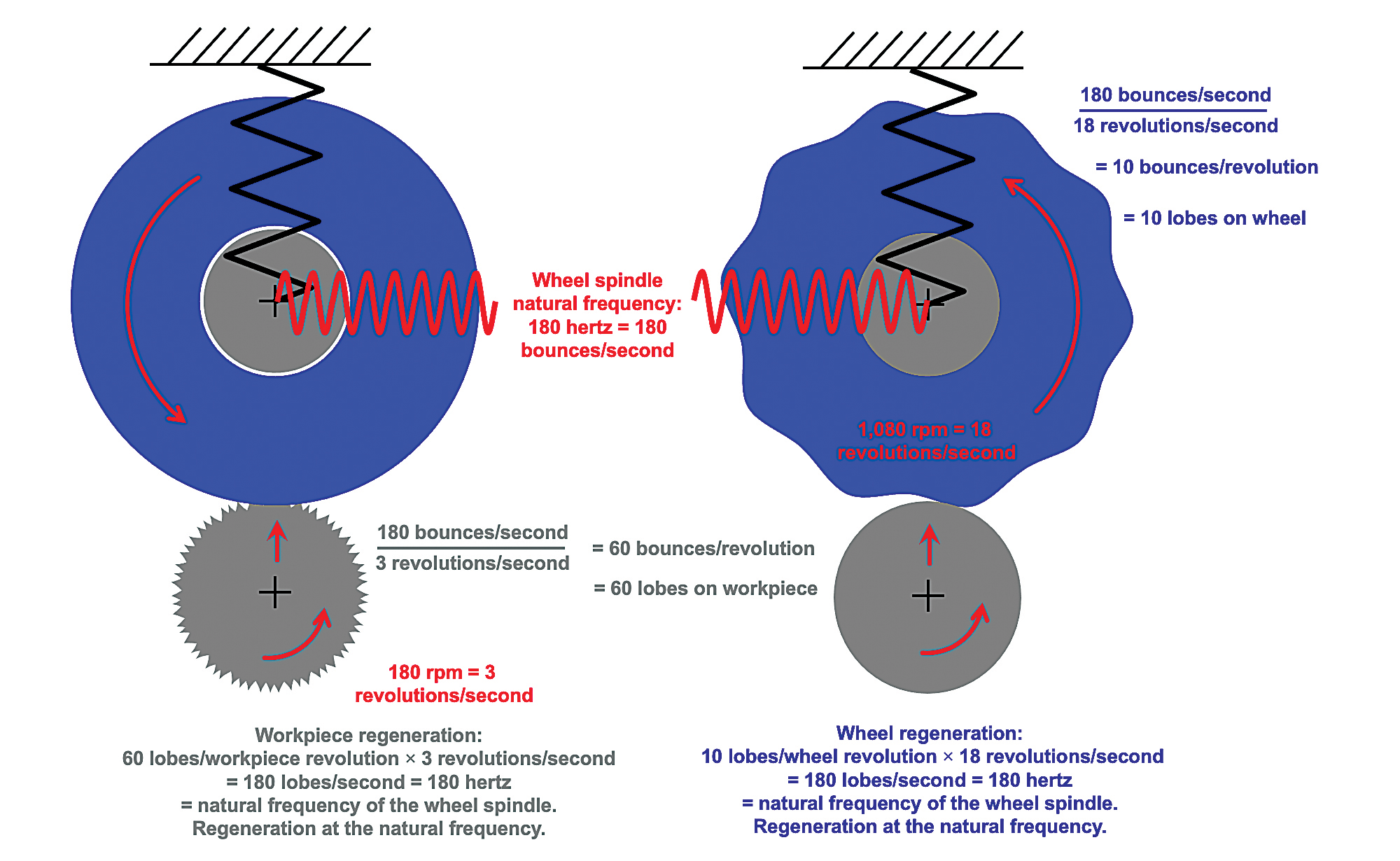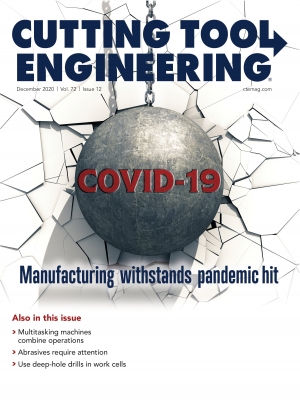Dear Doc: We cylindrical OD-grind steel shafts. Our machine has options for varying the wheel and/or workpiece rpm to reduce chatter risk. How does this work?
The Doc replies: In the first option, the machine varies the workpiece rpm up and down a few percent (say, sinusoidally from 160 to 200 rpm instead of a constant 180 rpm) over a short period (usually a few seconds) to reduce “workpiece regenerative chatter.” It’s hard to explain why in less than 500 words, but I’ll try. The wheel spindle likes to bounce up and down at its natural frequency — say, 180 bounces per second. (See the figure.) This creates 60 lobes on the workpiece (180 bounces/second ÷ 3 revolutions/second). In subsequent workpiece revolutions, these lobes cause the grinding depth of cut to vary, creating a varying force pushing up on the spindle. This is an “excitation force,” which causes the wheel spindle to bounce up and down even more, creating even bigger lobes. To make things worse, because these lobes were created at the natural frequency, they now excite the wheel spindle at the natural frequency, causing chatter to become out of control.

By varying the workpiece rpm, we vary the distance between lobes. They’re still there, but because the distance doesn’t excite things at exactly the natural frequency, the situation isn’t exacerbated — and workpiece regenerative chatter is reduced. Hopefully.
The second option is for “wheel regenerative chatter,” which works much the same. Over time, the bouncing up and down of the wheel (at its natural frequency) causes uneven wheel wear, creating lobes on the grinding wheel. This is also an excitation source — at exactly the natural frequency — that exacerbates the chatter. These lobes take longer to develop (minutes or even hours instead of seconds). Here, we vary the wheel speed (again +/-10% but over a longer period, like every two minutes) to vary the distance between wheel lobes and make them obliterate themselves. They’re still there but not as high, and they’re not “exciting the system” at exactly the natural frequency.
Does it work? The answer is “sort of” and “sometimes.” It seems to work better on roll grinding.
But there are other benefits. First, it allows you to avoid the dreaded “integer values” (wheel rpm/workpiece rpm = 8.0000 or 9.0000 instead of 8.5972042), which cause workpiece lobing. Second, it allows you to avoid running the wheel or workpiece at some other natural frequency (say, of the workpiece or machine base).
If it’s an easy modification, do it. But don’t expect miracles. Expect modest improvements. But modest improvements can add up.
Related Glossary Terms
- chatter
chatter
Condition of vibration involving the machine, workpiece and cutting tool. Once this condition arises, it is often self-sustaining until the problem is corrected. Chatter can be identified when lines or grooves appear at regular intervals in the workpiece. These lines or grooves are caused by the teeth of the cutter as they vibrate in and out of the workpiece and their spacing depends on the frequency of vibration.
- depth of cut
depth of cut
Distance between the bottom of the cut and the uncut surface of the workpiece, measured in a direction at right angles to the machined surface of the workpiece.
- grinding
grinding
Machining operation in which material is removed from the workpiece by a powered abrasive wheel, stone, belt, paste, sheet, compound, slurry, etc. Takes various forms: surface grinding (creates flat and/or squared surfaces); cylindrical grinding (for external cylindrical and tapered shapes, fillets, undercuts, etc.); centerless grinding; chamfering; thread and form grinding; tool and cutter grinding; offhand grinding; lapping and polishing (grinding with extremely fine grits to create ultrasmooth surfaces); honing; and disc grinding.
- grinding wheel
grinding wheel
Wheel formed from abrasive material mixed in a suitable matrix. Takes a variety of shapes but falls into two basic categories: one that cuts on its periphery, as in reciprocating grinding, and one that cuts on its side or face, as in tool and cutter grinding.


